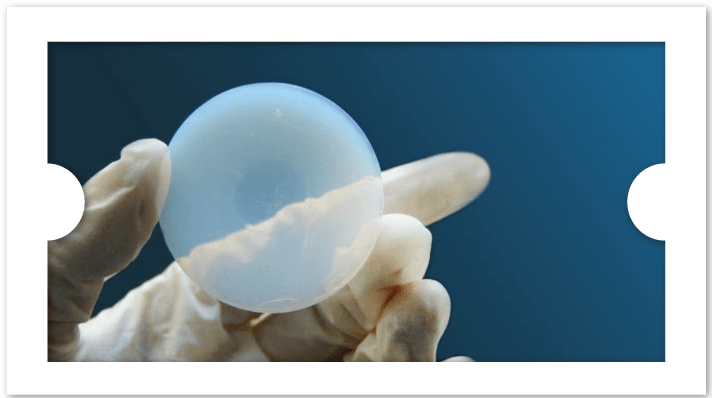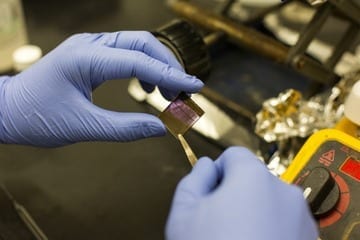
A research team headed by Professor Gao Chao have developed ultra-light aerogel – it breaks the record of the world’s lightest material with surprising flexibility and oil-absorption.
This progress is published in the “Research Highlights” column in Nature.
Aerogel is the lightest substance recorded by Guinness Book of World Records. It gets its name due to its internal pores filled with air. In 1931, American scientist Kistler first produced aerogel with silicon dioxide, and nicknamed it “frozen smoke”. In 2011, HRL Laboratory, University of California Irvine, and California Institute of Technology collaborated in developing nickel aerogel with a density of 0.9 mg/cubic centimeter, the record lightest material at that time. It couldn’t even cause deformation on dandelion flower fluffs. The picture of nickel aerogel was selected as one of the top ten pictures of Nature. Deeply impressed by the picture, Prof. Gao Chao asked himself: is it possible to challenge the limit with new material?
Gao Chao’s team has long been developing macroscopic graphene materials, such as one-dimensional graphene fibers and two-dimensional graphene films. This time they decided to make three-dimensional porous material out of graphene to break the record. In their lab, the reporter saw carbon sponges of different sizes, as big as tennis balls or as small as bottle stopper. Under an electron microscope, carbon nanotubes and graphene support numerous pore. “It’s somewhat like large space structures such as big stadiums, with steel bars as supports and high strength film as walls to achieve both lightness and strength.” Ph.D. candidate Sun Haiyan introduced. “Here, carbon nanotubes are supports and graphene is the wall.”
In reported papers the carbon sponge developed by Gao’s team is the record holder of lightest material, with 0.16 mg/cubic centimeter, lower than the density of helium. A related paper was published in Advanced Materials on February 18. But the team is not interested in declaring for Guinness Book of World Records. Prof. Gao explains that the value of this achievement lies in its simple way in developing the material and the superior performance exhibited.
The basic principle of developing aerogel is to remove solvent in the gel and retain the integrity. In the past, scientists usually used sol-gel method and template-oriented method. The former can synthesize aerogel on a large scale, but with poor controllability. The latter can generate ordered structures; but due to its reliance on the fine structure and dimensions of templates, mass production was feasible. Prof. Gao’s team explored a new method — freeze-drying method: they freeze-dried solutions of carbon nanotubes and graphene to get carbon sponge that can be arbitrarily adjusted in any shape. “With no need for templates, its size only depends on that of the container. Bigger container can help produce the aerogel in bigger size, even to thousands of cubic centimeters or larger.”
The title of review in Nature is “Solid carbon, springy and light”. This new material is amazing. Their aerogel is extremely elastic, bouncing back when compressed. It can absorb up to 900 times their own weight in oil, only oil not water. In addition, the aerogel can absorb organics at a high speed: one gram of such aerogel can absorb 68.8 grams of organics per second. It can be useful in dealing with oil spills at sea.
The Latest Bing News on:
Ultra-light aerogel
- Researchers achieve ultra-high-Q free space coupling to microtoroid resonatorson May 16, 2024 at 11:30 am
Scientists from the University of Arizona have achieved far-field coupling of light to ultra-high quality factor microtoroids using a single objective lens. This could provide the foundation for a ...
- Best Ultrabooks: Thin and Powerful Laptops for Every Purposeon April 29, 2024 at 12:03 pm
The most amazing Ultrabooks right now easily take on almost any workload with capable internals inside a thin, light frame ... ll enjoy the perfectly sized, ultra-crisp Liquid Retina XDR display ...
- This new Ultra phone could actually be overkill for low-light photoson April 16, 2024 at 5:01 pm
A new leak suggests the upcoming HUAWEI Pura 70 Ultra phone could have the best camera for low-light shots. The leak points to the phone packing a one-inch main camera and an RYYB color filter.
- Razer Blackshark V2 Hyperspeed review: A headset with a very good micon April 12, 2024 at 7:30 am
The Razer Blackshark V2 Hyperspeed undergoes our critical review and promises a lot: an ultra-light design, outstanding microphone quality, and a sound tuning specially optimized for esports.
- Empa Scientists Pioneer 3D Printing of Cellulose-Based Aerogelson April 5, 2024 at 10:13 am
Ultra-light, thermally insulating and biodegradable: Cellulose-based aerogels are versatile. Empa researchers have succeeded in 3D printing the natural material into complex shapes that could one ...
- Biodegradable Aerogel: Airy Cellulose Materials From a 3D Printeron April 4, 2024 at 5:00 pm
All three have great potential for the future, however: "green" materials do not pollute the environment, 3D printing can produce complex structures without waste, and ultra-light aerogels are ...
- Biodegradable aerogel: Airy cellulose from a 3D printeron April 4, 2024 at 8:18 am
All three have great potential for the future; however, "green" materials do not pollute the environment, 3D printing can produce complex structures without waste, and ultra-light aerogels are ...
- Shark Rocket Zero-M Ultra-Light HV345 (Sam's Club) Vacuum Cleaneron February 5, 2024 at 12:06 pm
The Shark Rocket Zero-M Ultra-Light HV345 (Sam's Club) is part of the Vacuum Cleaners test program at Consumer Reports. In our lab tests, Stick Vacuums (Corded) models like the Rocket Zero-M Ultra ...
- Ultra Lightweight climbing rope Volta 9.2 mmon September 11, 2023 at 1:05 am
Ultra lightweight climbing rope, 9.2 mm diameter for performance climbing and mountaineering • Ultra-lightweight rope for performance climbing and mountaineering: - Great diameter-to-weight ratio - ...
- Ultra Light VORON X-Beam Milled From Aluminium Tube Stockon May 30, 2022 at 6:35 pm
When it comes to 3D printing using fused deposition modeling (FDM) technology, there are two main groups of printers: Cartesian and CoreXY, with the latter being the domain of those who wish to ...
The Latest Google Headlines on:
Ultra-light aerogel
[google_news title=”” keyword=”ultra-light aerogel” num_posts=”10″ blurb_length=”0″ show_thumb=”left”] [/vc_column_text]The Latest Bing News on:
World’s lightest material
- 8 of the best backpacks for Disney Worldon May 17, 2024 at 3:04 pm
Getting around Disney is much easier when you have your hands free to run down Main Street USA with reckless abandon, double fist Mickey Mouse pretzels, churros or a refreshing Dole Whip like nobody's ...
- World’s first 3D-printed wedding dress took nearly a month to make: ‘Masterpiece’on May 17, 2024 at 10:46 am
Mariana Pavani walked down the aisle in a custom gown that marked a big day for not just for the bride but for fashion history, too: Dutch designer Iris van Herpen had used a 3D printer to craft the ...
- I put the "world’s lightest” suitcase to the teston May 16, 2024 at 3:42 am
Horizn's new 'Air' suitcase claims to be 30% lighter than regular luggage, so I tried it out. Read our review here.
- Cotton candy exoplanet is 2nd lightest planet ever foundon May 16, 2024 at 12:57 am
The extrasolar planet or " exoplanet " named WASP-193 b is around 1.5 times the width of Jupiter but has just over a tenth of the solar system gas giant's mass. This makes it the second-lightest ...
- 16 Lightweight Summer Clothes That Won’t Leave You Feeling Damp on Your Sweatiest Dayson May 8, 2024 at 10:45 am
If you're sick of feeling (and looking) damp and sweaty in your summer fashion, try these lightweight clothing finds — see all ...
- Origin Materials Introduces World’s First Tethered PET Beverage Cap for Improved Recycling Circularityon May 7, 2024 at 4:00 am
Origin Materials ("Origin") (NASDAQ: ORGN, ORGNW), the world’s leading carbon negative materials company with a mission to enable the world’s transition to sustainable materials, today announced ...
- Origin Materials unveils “world’s lightest” carbonated soft drink PET capon May 7, 2024 at 3:30 am
Origin Materials, a company specialising in the development of carbon-negative materials, has launched the Carbonated Soft Drink (CSD) PET Cap, said to be the lightest cap of its kind ever produced ...
- Origin Materials launches world's lightest PET bottle caon May 6, 2024 at 1:20 pm
Origin Materials, a company focused on carbon-negative materials, announced today its latest innovation in sustainable packaging: the world's lightest carbonated soft drink (CSD) cap made entirely ...
- Origin Materials launches world's lightest PET bottle caon May 6, 2024 at 8:19 am
a company focused on carbon-negative materials, announced today its latest innovation in sustainable packaging: the world's lightest carbonated soft drink (CSD) cap made entirely from polyethylene ...
- Origin Materials Introduces World’s First CSD (Carbonated Soft Drink) PET Cap, the Lightest of its Kind Ever Produced Commerciallyon May 6, 2024 at 4:01 am
The initial product is the world’s lightest CSD (carbonated soft drink ... and expanding the use of recycled material.” Origin’s 1881 closure offers a superior-performance lightweight ...
The Latest Google Headlines on:
World’s lightest material
[google_news title=”” keyword=”world’s lightest material” num_posts=”10″ blurb_length=”0″ show_thumb=”left”]











